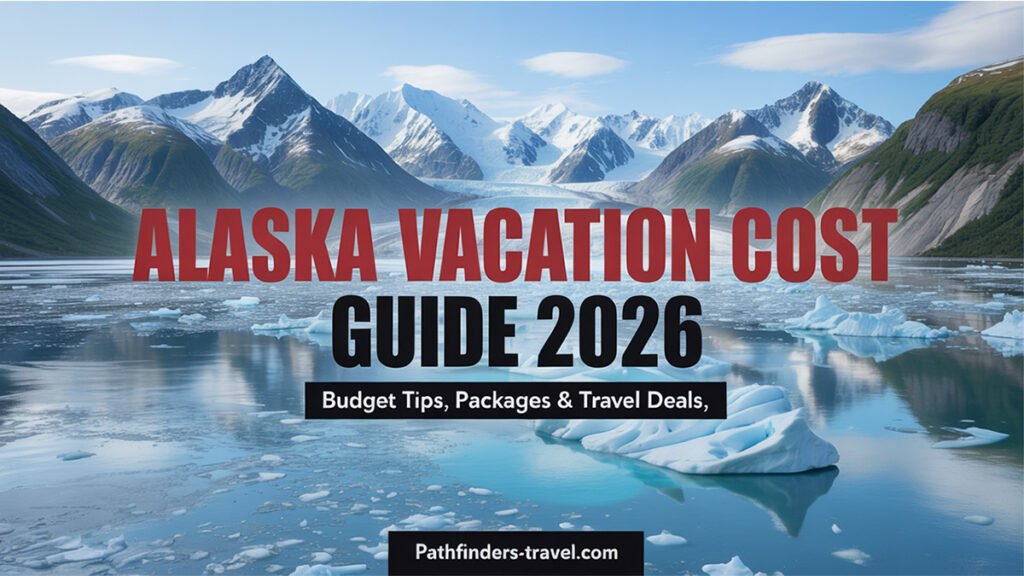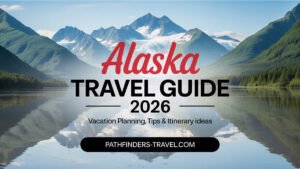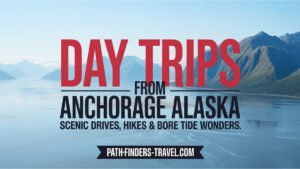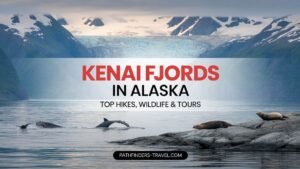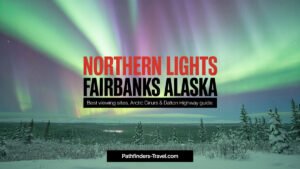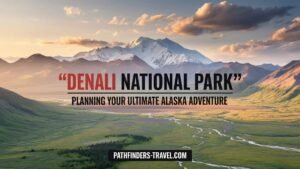Estimated reading time: 13 minutes
Last Modified Date: September 24, 2025
Key Takeaways
- The average cost of an Alaska vacation ranges from $3,000–$4,000 per person for a 7-day trip. Mid-range hotels average $250–$450 per night in Anchorage, Juneau, and other popular destinations. like Anchorage and Juneau per person for a 7-day trip, or roughly $400-$600 per day.
- Budget travelers can experience Alaska for $150-$250 per day by choosing camping accommodations, preparing their own meals, and focusing on free outdoor activities.
- Significant cost savings (10-18%) are possible by traveling during shoulder seasons (May and September) instead of peak summer months.
- Accommodation costs vary widely from $100-$450+ per night in summer, while rental cars typically cost $100-$200 daily.
- Bundled vacation packages can simplify logistics and potentially reduce overall costs compared to booking components separately.
Table of Contents
- Introduction
- Understanding Alaska Trip Expenses
- Planning Your Alaska Travel Budget
- Affordable Alaska Travel Tips
- Alaska Vacation Packages and Travel Deals
- Destination Highlights on a Budget
- Additional Cost-Saving Considerations
- Frequently Asked Questions about Alaska Vacation Costs
- Conclusion
Introduction
Alaska stands as a bucket-list destination for many travelers, renowned for its awe-inspiring natural wonders. From towering glaciers and rugged fjords to abundant wildlife and iconic national parks, this vast northern state offers experiences unlike anywhere else in the world. For travelers planning to visit this pristine wilderness, understanding the Alaska vacation cost becomes a central consideration in balancing dream experiences with practical budget constraints.
Throughout this article, we’ll clarify the typical costs associated with Alaska travel, offer practical budgeting strategies, highlight ways to reduce expenses, and explore options for affordable travel experiences. Whether you’re interested in wildlife viewing, glacier trekking, or cultural exploration, we’ll cover vacation packages and the latest travel deals so you can experience Alaska’s wonders without breaking the bank.
Want to see this for yourself? Click here to watch the Wonders of Alaska in 4K UHD resolution.
Understanding Alaska Trip Expenses and Seasonal Price Variations
Factors Contributing to Trip Costs
Several key factors shape your total Alaska trip expenses. Understanding these components helps create a realistic budget:
Accommodations vary dramatically across Alaska. In peak summer months, mid-range hotels average $250-$450 per night in popular destinations like Anchorage and Juneau. Budget options start around $100 nightly, while luxury properties can exceed $500, particularly in remote locations [SOURCE].
Transportation costs reflect Alaska’s vast geography. Rental cars typically run $100-$200 daily during summer, with gas prices higher than the continental US average. In many regions, planes or ferries are necessary, especially for visiting non-road-connected towns like Juneau, adding to overall expenses [SOURCE].
Food prices in Alaska exceed mainland US costs. Grocery shopping costs about 20-30% more, while restaurant meals in tourist areas command premium prices. A moderate food budget averages $50-$80 per person daily [SOURCE].
Tours and Activities often represent the largest variable expense. A single flightseeing tour can exceed $500 per person; bear viewings and glacier hikes also command premium prices. Even moderate activities like rafting, museum entries, and wildlife cruises typically cost between $80-$175 each [SOURCE].
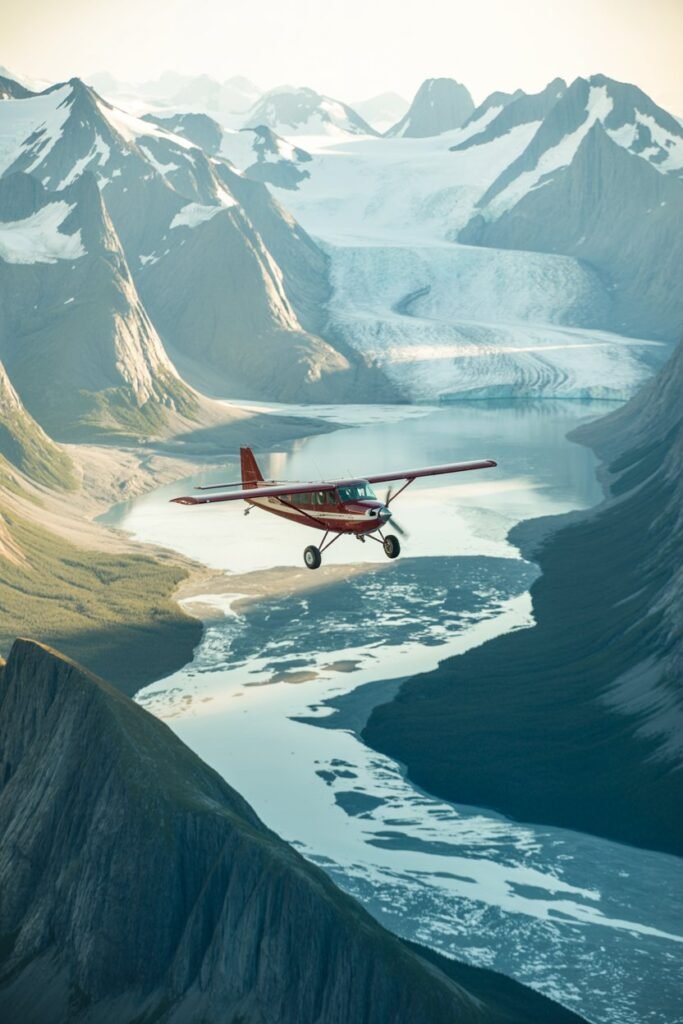
Seasonal Cost Variations
When you visit significantly impacts your Alaska vacation cost:
Peak Season (mid-June through August) brings the highest prices for lodging, car rentals, and tours. This period offers optimal weather and extended daylight but comes with premium pricing and larger crowds [SOURCE].
Shoulder/Off-Peak Seasons (May, September) offer savings of 10-18% on key travel components. These months still provide good wildlife viewing and reasonable weather with fewer crowds, though some attractions may have limited operating hours [SOURCE].
Sample Alaska Travel Budget
For a 7-day Alaska trip in 2026, expect these general costs per person:
- Average traveler: $3,000-$4,000 total ($400-$600 daily)
- Budget traveler: $1,000-$2,000 total ($150-$250 daily)
- Luxury experience: $5,000+ total ($700+ daily)
Budget travelers can reduce costs significantly by camping instead of hotels, preparing simple meals, and prioritizing free activities like hiking in national parks [SOURCE].
Planning Your Alaska Travel Budget and Daily Cost Estimates
Tips for Accurate Budgeting
Creating a realistic Alaska travel budget requires thoughtful planning and research. Here are practical tips to help you build an accurate financial framework for your northern adventure:
Start with a daily cost estimate as your baseline. For most travelers, this ranges from $400-$600 per day, but adjust according to your personal travel style and preferences. This baseline helps establish reasonable expectations for your total trip cost.
When evaluating lodging options, compare various accommodation types to find the best value:
- Hotels/B&Bs: $100-$450+ nightly during summer
- Hostels: $40-$80 per night in major towns (limited availability)
- Cabins: $75-$200 nightly, often with kitchenettes
- RV rentals: $200-$400 daily but combine transportation and lodging
- Camping: $0-$25 nightly (requires equipment)
For transportation planning, weigh the pros and cons of different options:
- Car rental: Most flexible but costly ($100-$200 daily plus gas)
- Trains/coaches: More economical for solo travelers
- Ferries: Necessary for Southeast destinations (variable pricing)
- Internal flights: Expensive but sometimes unavoidable for reaching remote areas
Prioritize affordable activities to keep your budget under control. Alaska offers many low-cost or free experiences that deliver authentic encounters with nature:
- Hiking on public trails (around Anchorage, Denali, Kenai Peninsula)
- Visiting state and national parks (some entry fees apply)
- Exploring scenic drives
- Attending local cultural events and markets
- Taking advantage of free ranger-led programs at national parks
Consider creating a comprehensive Alaska travel guide for your trip that includes your budget breakdown by category. This visual representation helps identify areas where you might need more financial flexibility or where you can cut back.
Affordable Alaska Travel: Tips for Off-Season and Regional Itineraries
Strategies for Cost-Effective Travel
Experiencing Alaska’s natural grandeur doesn’t have to drain your savings. These actionable strategies for affordable Alaska travel can help you maximize your northern adventure while minimizing costs:
Travel off-season for significant savings. Visiting in May or September offers cost breaks of 10-18% on hotels and tours, with fewer crowds and more local deals. May typically offers drier weather, while September brings fall colors and possible northern lights sightings.
Book well in advance to secure the best rates and availability. Many accommodations and tours sell out 9-12 months ahead, especially budget options and popular experiences [SOURCE].
Focus your itinerary geographically to save on transportation costs. Rather than trying to see everything, explore one region in depth. For example, concentrate on Anchorage and the Kenai Peninsula, or the Denali area, rather than attempting to cover the entire state.
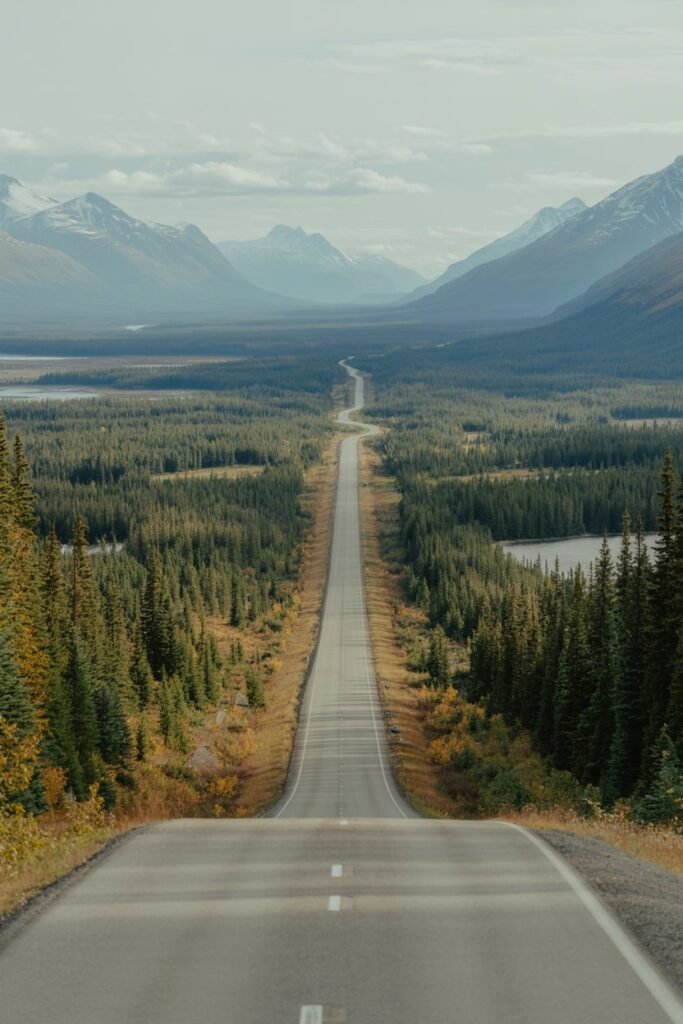
Learn how to get to Alaska using the most cost-effective transportation options for your specific situation.
Leverage travel points and miles for flights and hotels wherever possible. Alaska routes often offer good redemption value for airline miles, and hotel loyalty programs can reduce accommodation costs significantly.
Look for local discounts through visitor centers, city passes, and bundled day tours. Many attractions offer package deals that combine popular sites at reduced rates compared to individual bookings.
Use affordable transportation alternatives like:
- Turo for peer-to-peer car rentals (often cheaper than agencies)
- The Alaska Ferry for coastal travel (slower but scenic and cost-effective)
- Public transportation in Anchorage and Juneau
- Park shuttles in Denali National Park
Minimize dining expenses by shopping at local markets and preparing your own meals when possible. Accommodations with kitchenettes or access to communal cooking facilities can dramatically reduce food costs.
Alaska Vacation Packages, Cruise Options, and Travel Deals
Advantages of Bundled Packages
Alaska vacation packages offer several compelling benefits for travelers looking to simplify planning while potentially reducing costs:
Bundled deals typically combine lodging, transportation, and select activities into one comprehensive price. This all-in-one approach often yields cost savings of 10-15% compared to booking components separately, especially during peak season.
Beyond savings, packages simplify complex logistics in a state where transportation connections can be challenging to coordinate. This is particularly valuable in regions like Southeast Alaska, where ferry schedules, flight connections, and accommodation availability must align perfectly.
Popular types of packages include:
- Independent land tours (self-guided with pre-arranged logistics)
- Small group guided tours (typically 8-16 people)
- Cruise-and-land combinations
- Adventure-focused itineraries (wildlife, photography, hiking)
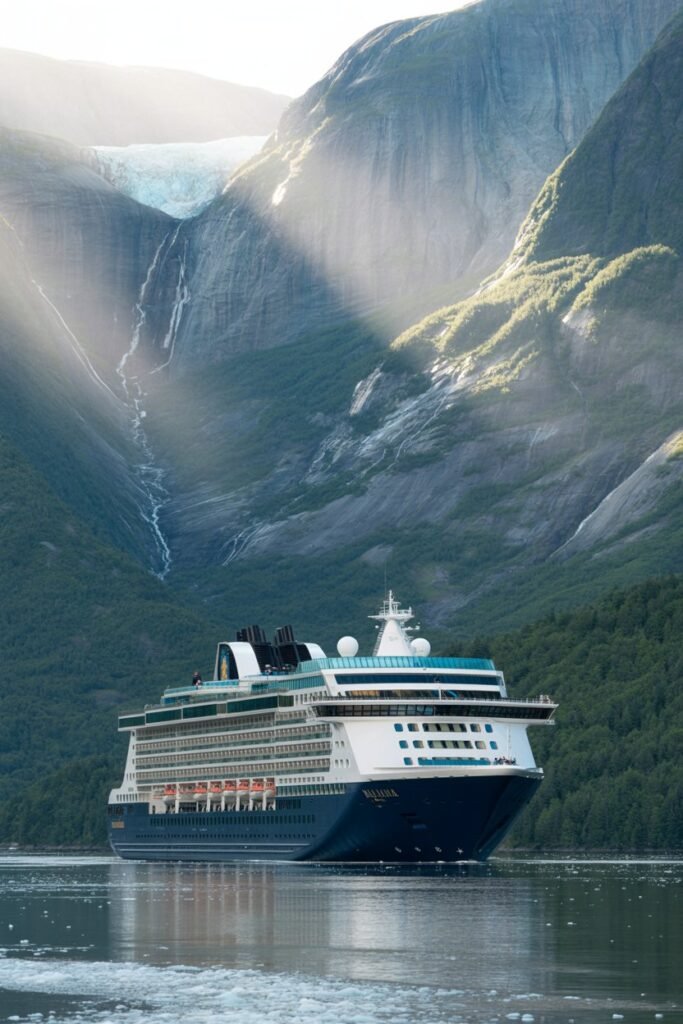
Finding the Best Travel Deals
To discover the most attractive Alaska travel deals, focus your search on these resources:
- Alaska tourism official websites
- Major cruise lines’ early booking promotions
- Local Alaskan tour operators (often more flexible and personalized)
- Reputable travel agencies specializing in Alaska
The best timing for finding deals is typically January through March, when most early-booking discounts are released for the upcoming summer season [SOURCE].
Cost Comparison: Independent vs. Package Travel
| Travel Style | Key Advantages | Typical Cost Range (Per Person, 7 Days) |
|---|---|---|
| Independent Budget | Maximum flexibility, lowest possible cost | $1,000–$2,000 |
| Package (Land) | Convenience, inclusive activities | $2,400–$4,000 |
| Cruise Packages | All-inclusive, minimal planning | $2,000–$4,200 |
When evaluating packages, look beyond the headline price to understand exactly what’s included. Some “bargain” packages may exclude essential components like meals, transportation between activities, or entrance fees.
Destination Highlights on a Budget
Iconic Destinations and Affordable Experiences
Alaska’s most celebrated destinations offer budget-friendly options alongside premium experiences. Here’s how to enjoy these iconic locations without overspending:
Juneau: Alaska’s capital city offers several affordable activities:
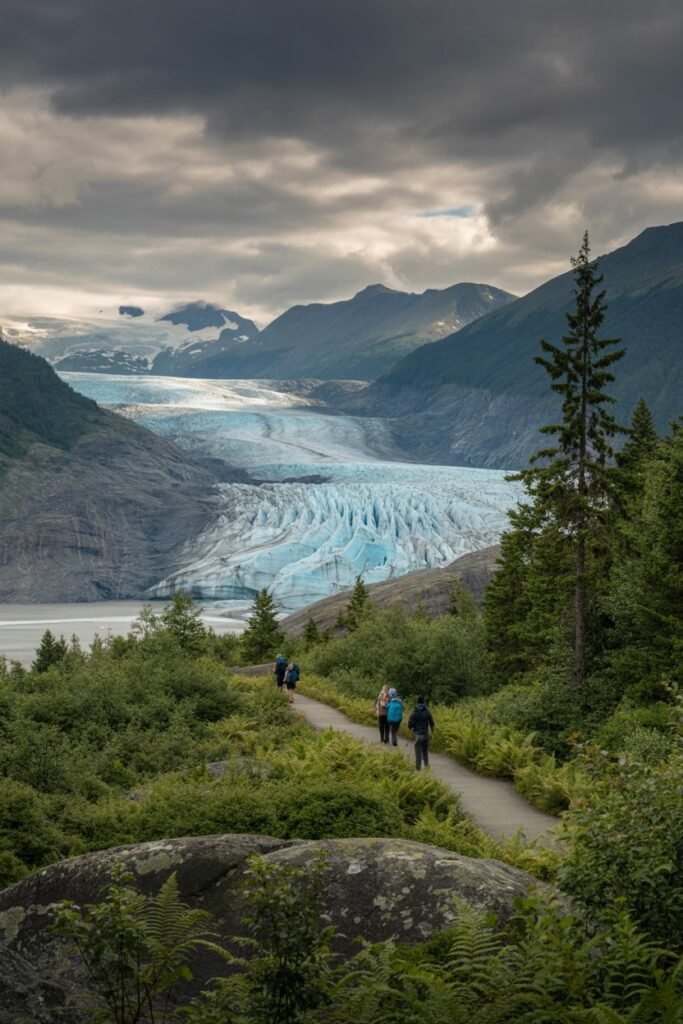
- Hike to Mendenhall Glacier on free public trails instead of taking guided tours
- Use public transportation ($2 per ride) to reach the visitor center
- Explore downtown historic sites on self-guided walking tours
- Visit the Alaska State Museum ($14 admission) for cultural insights
Seward: This gateway to Kenai Fjords National Park offers budget-conscious options [SOURCE]:
- Visit the park’s visitor center and nearby hiking trails for free
- Book shorter boat tours (3-4 hours instead of 6-8) to see glaciers and wildlife for less
- Explore the free Alaska SeaLife Center outdoor areas
- Hike the Harding Icefield Trail for spectacular glacier views without tour costs
Denali National Park: Experience this magnificent wilderness affordably:
- Take the shuttle bus instead of private tours (saves 40-60%)
- Join free ranger-led hikes and programs
- Stay at the park campgrounds rather than nearby hotels
- Pack lunches instead of buying food at the visitor centers
Anchorage: Alaska’s largest city offers many budget-friendly activities:
- Explore over 100 miles of urban trails on foot or by renting a bike
- Visit the Anchorage Market on weekends (free admission)
- Attend free summer concerts in parks
- Tour the Alaska Public Lands Information Center at no cost
Skagway & Ketchikan: These popular cruise ports can be explored inexpensively:
- Walk historic downtowns using free self-guided tour maps
- Hike nearby trails for views comparable to paid tours
- Visit public totem parks and cultural sites with minimal fees
- Choose one shorter excursion rather than multiple tours
Additional Cost-Saving Considerations
Practical Tips for Reducing Expenses
Beyond the major budget categories, these practical approaches can further reduce your Alaska vacation cost:
Pack efficiently to avoid baggage fees and unnecessary purchases. Alaska’s weather can change rapidly, so bring layers rather than buying clothing locally at premium prices. Essential items include weatherproof outerwear, hiking boots, binoculars, and sun protection.
Shop at local markets for groceries and supplies. Fred Meyer and Carrs-Safeway stores are found in larger towns, while smaller communities may have limited options. Farmers markets in summer offer fresh local produce, though at higher prices than chain stores.
Bring a reusable water bottle and filter. Alaska’s tap water is generally excellent, and this simple habit saves both money and plastic waste during your trip.
Research tours carefully to avoid tourist traps. Read recent reviews, compare prices across providers, and ask specific questions about what’s included. Sometimes, smaller, locally owned operations offer more authentic experiences at lower prices than heavily advertised attractions.
Be aware of hidden fees that can impact your budget:
- Fuel surcharges on small flights
- Activity gear rental fees (fishing equipment, kayaks, etc.)
- Sales tax in some municipalities
- Parking fees in popular areas
- Standard 15-20% tipping expectations for guides and service staff
Build in a contingency fund of roughly $50-$100 per person for unexpected expenses or opportunities. This buffer helps manage the financial impact of weather cancellations, spontaneous wildlife viewing opportunities, or other unplanned situations.
Frequently Asked Questions about Alaska Vacation Costs
When is the best time to visit Alaska to save money on lodging and tours?
The best value generally comes during the shoulder seasons: early May, June (just before peak), and September. During these months, lodging, tours, and even cruises often offer discounts of 10–25% compared to peak summer pricing, while still allowing for good weather and wildlife viewing opportunities.
How much does a typical week in Alaska cost per person in 2026?
For a 7-day trip in 2026, expect to spend about $3,000–$4,000 per person for a mid-range Alaska travel budget, averaging $400–$600 per day. Budget-conscious travelers might manage with $1,000–$2,000 total ($150–$250 daily) by choosing camping, self-prepared meals, and low-cost activities.
What are the biggest Alaska trip expenses travelers should plan for?
The main Alaska trip expenses include lodging, transportation within the state, guided tours and excursions, and meals. Costs can increase sharply during peak summer and in remote regions where fuel, food, and accommodations are more limited and carry higher premiums.
Are there free or affordable activities to include in an Alaska travel budget?
Yes. Many national parks offer free or low-fee entry, and visitors can enjoy hiking, scenic drives, self-guided cultural walks, and free ranger-led programs. Exploring these options allows travelers to stretch their Alaska travel budget without missing the state’s highlights.
How can I reduce transportation and lodging costs on an Alaska vacation?
You can lower costs by booking early, considering hostels, cabins, or campgrounds, and renting an RV to combine lodging with transport. Using ferries, shuttles, or public transit instead of internal flights also helps reduce expenses, especially if traveling in the off-season.
Conclusion
Planning your Alaska travel budget carefully ensures you experience the state’s landscapes and culture without financial stress. From accommodations and transportation to excursions and meals, understanding your Alaska vacation cost ahead of time helps set realistic expectations.
By timing your trip during the shoulder season, booking early, and choosing affordable activities such as hiking or ranger-led programs, you can reduce expenses while still enjoying Alaska’s most iconic attractions. Vacation packages and bundled travel deals can also provide savings and simplify logistics.
Some of Alaska’s most memorable moments—like watching the northern lights, spotting wildlife, or exploring glacier-fed trails—require little or no extra cost. Balancing premium tours with free or low-cost activities ensures a fulfilling itinerary that matches your budget.
For further planning, you may find our comprehensive Alaska travel guide useful, as it offers detailed insights into routes, regions, and seasonal highlights. With flexibility and smart planning, your Alaska dream trip can be both affordable and unforgettable.
For stunning 4K footage of Alaska’s breathtaking landscapes and wildlife, visit Pathfinders Travel on YouTube, where you can watch spectacular travel documentaries that showcase Alaska and other wonders of the world in stunning ultra-high-definition resolution.

